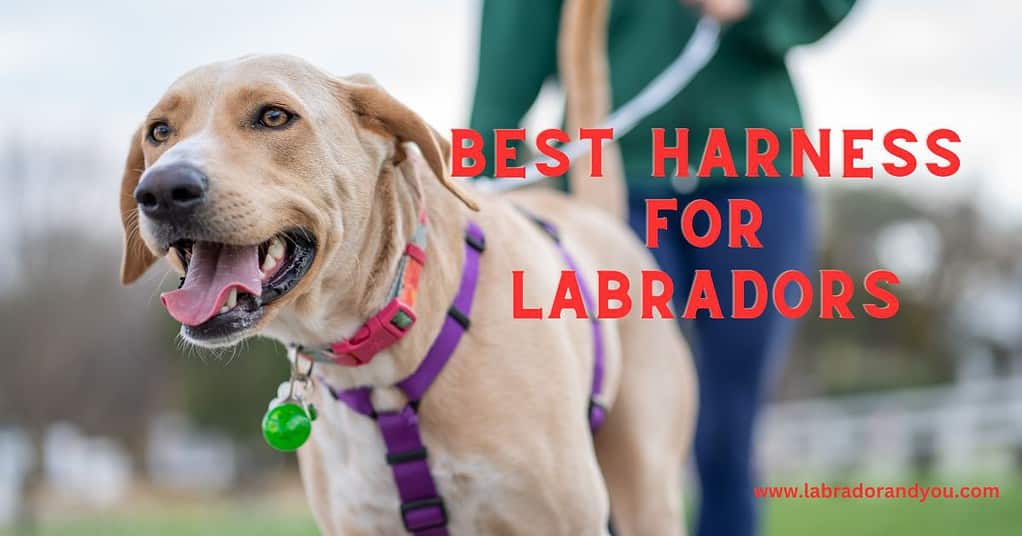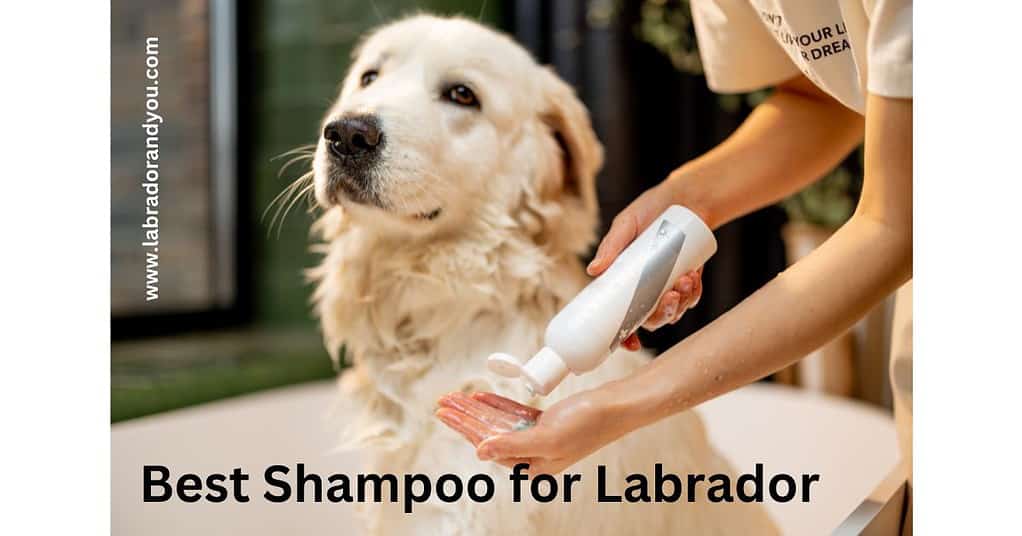Loyalty and playfulness make labrador retrievers one of the most popular breeds. A crate gives an active labrador a private space of its own. The best crate for labrador puppy is from metal wire. Its durability resists any damage.
For a young pup or an old one waiting to receive crate training, this guide will help. From the what size dog crate for a lab to usage tips, I’ll cover all. According to us, the best leakproof crate is Midwest Homes. The best by far.
10 best dog crate for labrador You Must Check
If you are looking to crate-train your labrador puppy for the first time or an adult dog crate, you’ll find your answers here. Always opt for a properly sized crate.
MidWest Homes: Best Leak-Proof Crate
The Midwest Homes crate has enhanced security features. Slide-bolt door latch blocks the paws and makes it safe and secure. A 30-inch crate is suitable for dogs weighing 25 to 40 pounds. Check the available dog crate sizes and buy depending on your dog.
It includes a leak-proof plastic pan, an updated lock system, and floor-protecting rollers for an excellent crate experience. You can fold it for easy storage and transport convenience. You can set up this crate quickly without major tools. It creates the perfect den-like space.
What stands out: – The rounded wire crate corners prevent injuries.
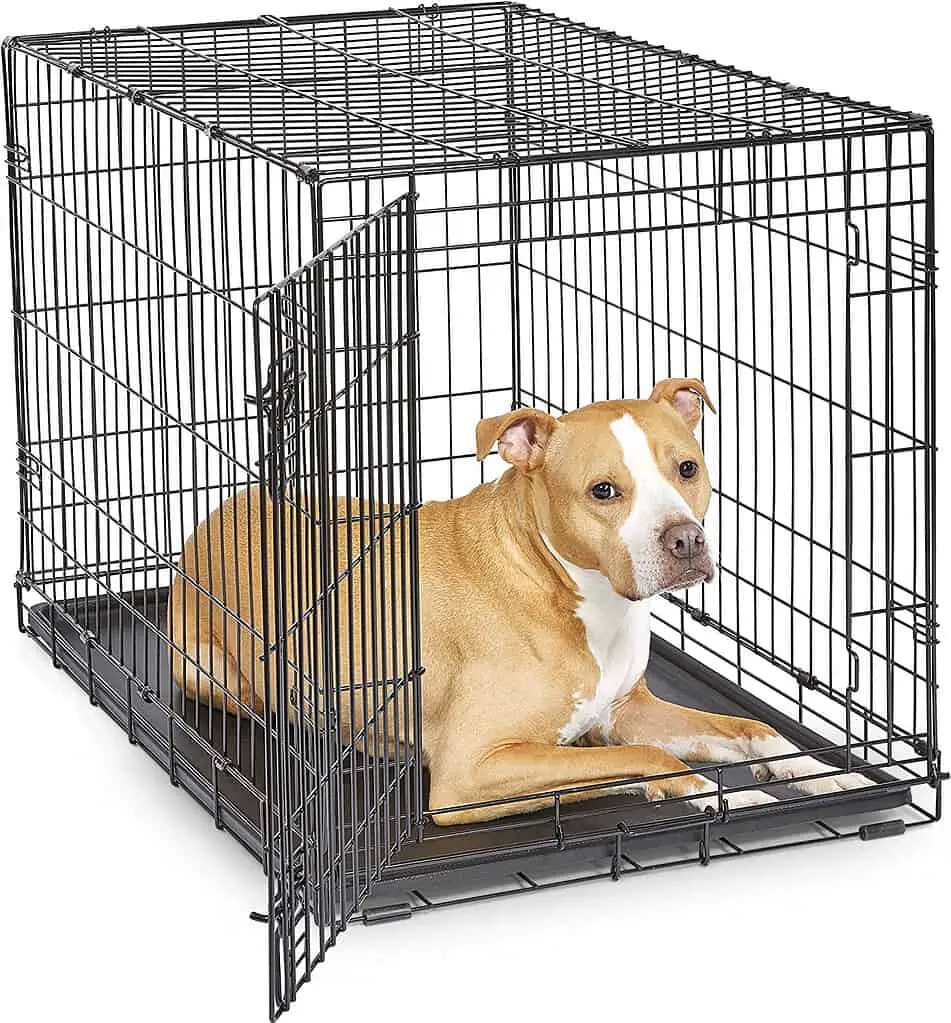
MidWest Homes Foldable Playpen
Exercise playpens are excellent for keeping pets healthy. Your labrador retriever can roam around freely despite being confined. Your dog gets 16 sq ft of space with this playpen. Optional tops are available to give a crate-like feel. You can purchase the sunscreen or wire mesh top separately for more security.
The playpen folds flat and is similar to a folding metal dog crate. It can be secured outdoors with the ground stakes that come along. The e-coating finish protects it from rust and outdoor weather. It is easy to assemble and makes a good pet playground.
What stands out:- The included clips allow you to unfold the panel and clip them.
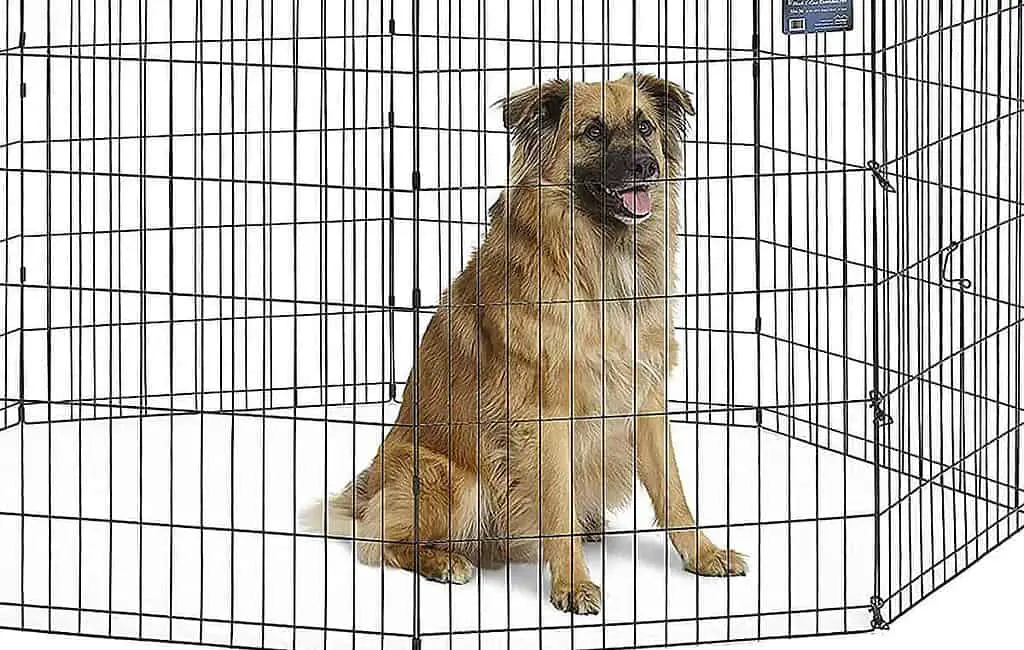
AmazonBasics
Looking for a soft-sided carrier crate for your Labrador? This Amazonbasics crate can be a perfect match. It has multiple screened panels and is well-ventilated. Your dog can see what’s going on outside.
Take advantage of the included fuzzy fleece liner bed for easy settlement. The shoulder strap and top handle make it a dynamic carrier.
Made of PVC and polyester, the crate is durable. You will not be buying multiple crates when you have this. The item can be stored with ease once collapsed down. It is among the best dog crates for medium and large dog breeds.
What stands out: – The accessory pockets are handy for storing toys and treats.
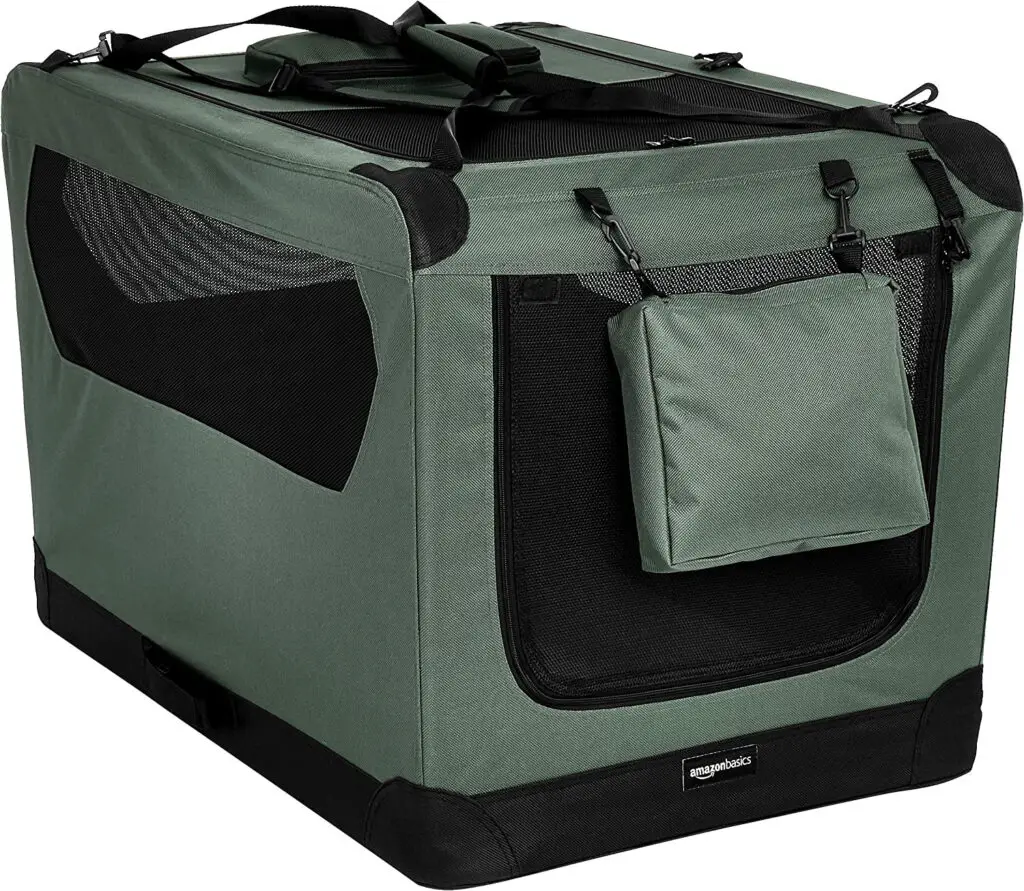
New Age Pet
How about disguising the pet crate as a furniture piece? Add it as an end table and keep your home decor intact. Spindles and latches are made of stainless steel, making this crate solid. Large and x-large crates have double latches for more robustness.
The crate is super easy to assemble with no tools required. The small crate size fits dogs weighing 20 lbs, and the x-large crate can hold up to 100 lbs. These furniture-style crates are available in russet brown, espresso black, grey, and antique white. Make this elegant addition to your home for both style and security.
What stands out:- The crate is made of a non-toxic recycled composite material, making it odorless and easy to clean.
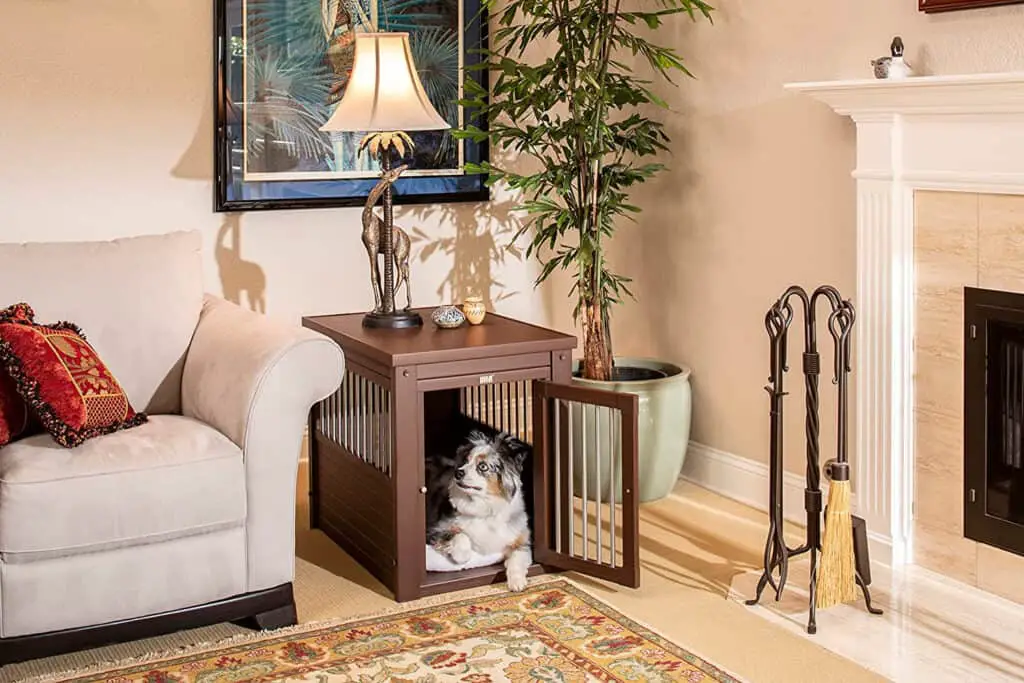
Carlson
Carlson’s single-door metal crate is collapsible, secure, removable, and portable. Certified by JPMA and ASTM standards, the metal bars are safe. It has a single door with a robust locking system. The doors allow the dog an easy in and out.
You can fold it flat for easy storage and travel needs. Carlson’s wire dog crate is appropriate for medium to large dog breeds. The sturdy crate has a removable bottom tray for easy cleaning. You can set it up in no time without major tools.
What stands out:- The multi-point lock on the door offers enhanced security.
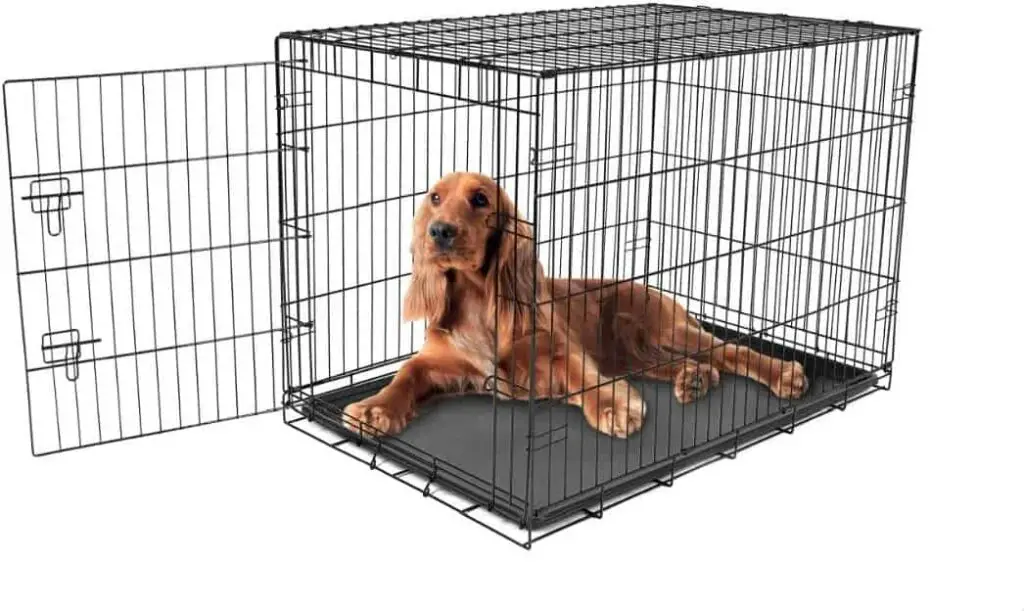
Petmate travel crate for labrador
The Petmate Ultra Vari 28″ kennel fits small to medium dogs. You will need a bigger crate size for larger dogs. This plastic travel crate cum kennel benefits air travel. The wire vents and tie-down strap holes keep the pet safe and comfortable.
Get 360-degree visibility with this travel crate. The combination of plastic and metal screws makes it heavy-duty. The stress-free assembly requires no tools or expert knowledge. The brand has over 50 years of experience in pet products and offers the best dog crates.
What stands out:- Easy-open latch offers a secure lock for pet parents to open easily.
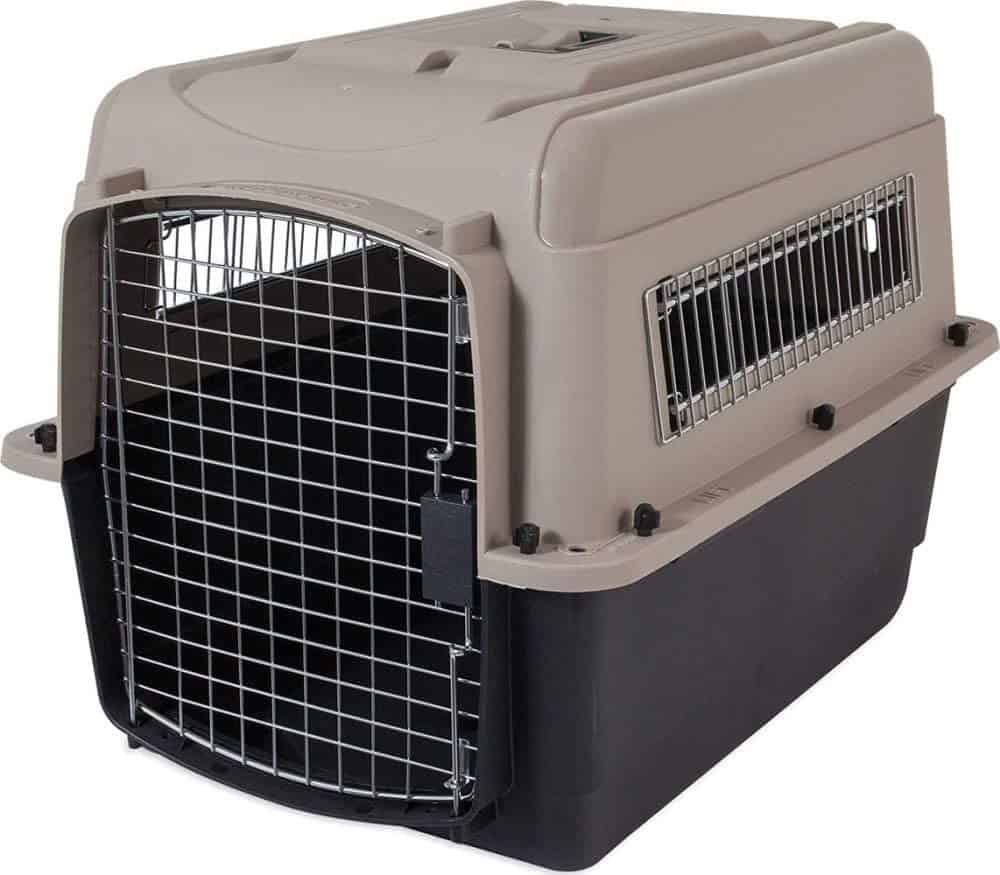
New World Double Door Crates
Want everything you need to get started with crate training together? The New World Double Door crate kit is an excellent deal. The double-door crate comes with a bed and dog crate cover. The waterproof tray and floor-protecting rubber feet are also included.
The goal is creating a cozy, den-like space to crate-train your lab. Enjoy more time with your canine friend as they are comfortable. Labrador retriever pup gets complete privacy with the cover. It signifies quiet time. The cover is made of polyester and is 100% washable.
What stands out:- The plush faux fur makes the dog bed extremely soft and comfortable.
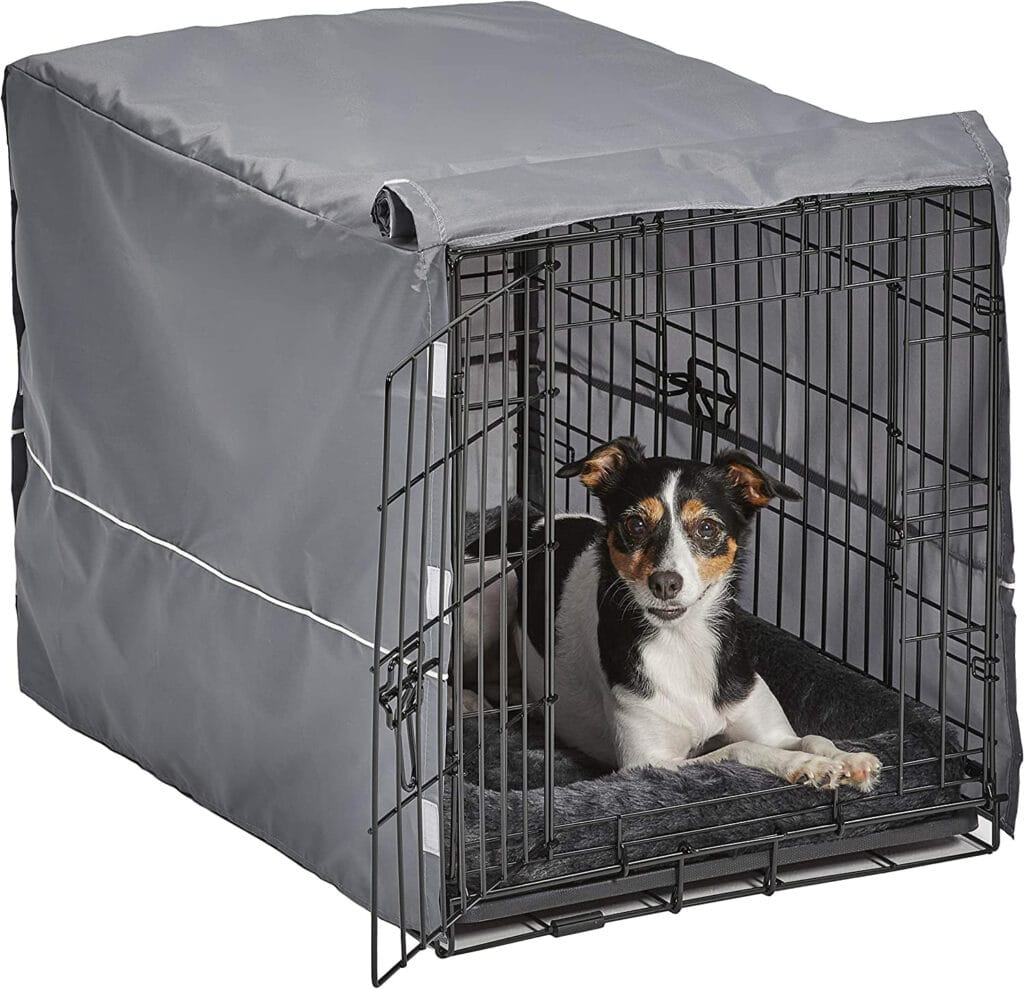
Precision Pet
This sturdy wire crate from Precision Pet is useful for medium dogs. It has 2 doors, and 5-precision point locks for maximum security. The crates can collapse to two inches for transport ease. It also has divider panels to adjust the crate. The dog grows, and a divider helps make the crate smaller or bigger.
The crate can be placed in multiple locations with the flexibility of two separate entrances. It is locked from the top and bottom and is a secure option. The rounded wire corners protects pets and prevents snagging. A heavy-gauge wire is used to increase its durability.
What stands out: – The crate comes with a rust-resistant e-coating.
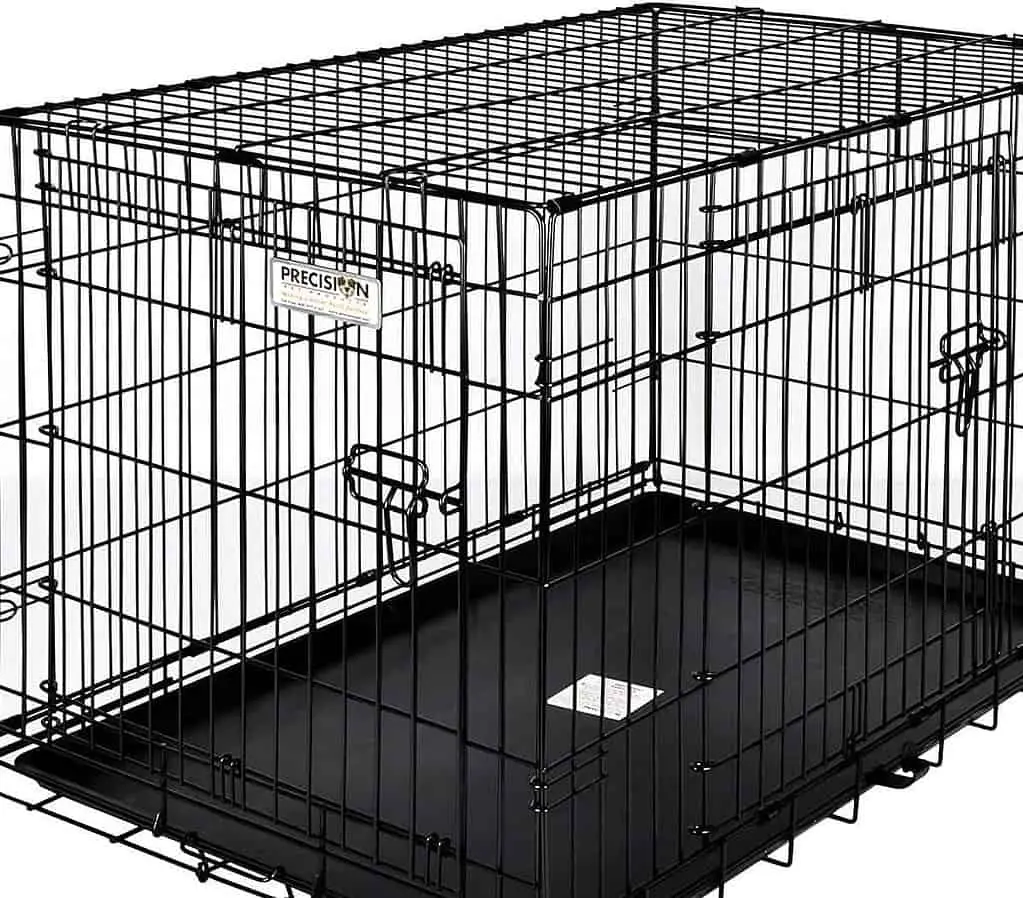
Merry Pet
While convertible cars are popular, convertible crates are not far behind. The Merry Pet 2-in-1 wooden crate can be converted into a gate. It offers your pet a secure resting space besides being an accent piece of furniture. Each panel can be removed to make small openings.
The crate requires no tools for assembling and is straightforward to set up. The additional plastic tray assists in keeping the floors clean. The furniture-style crate complements your home decor. You can place personal items on the crate top to make it multi-purpose.
What stands out:- The solid wood veneer cover is an additional perk.
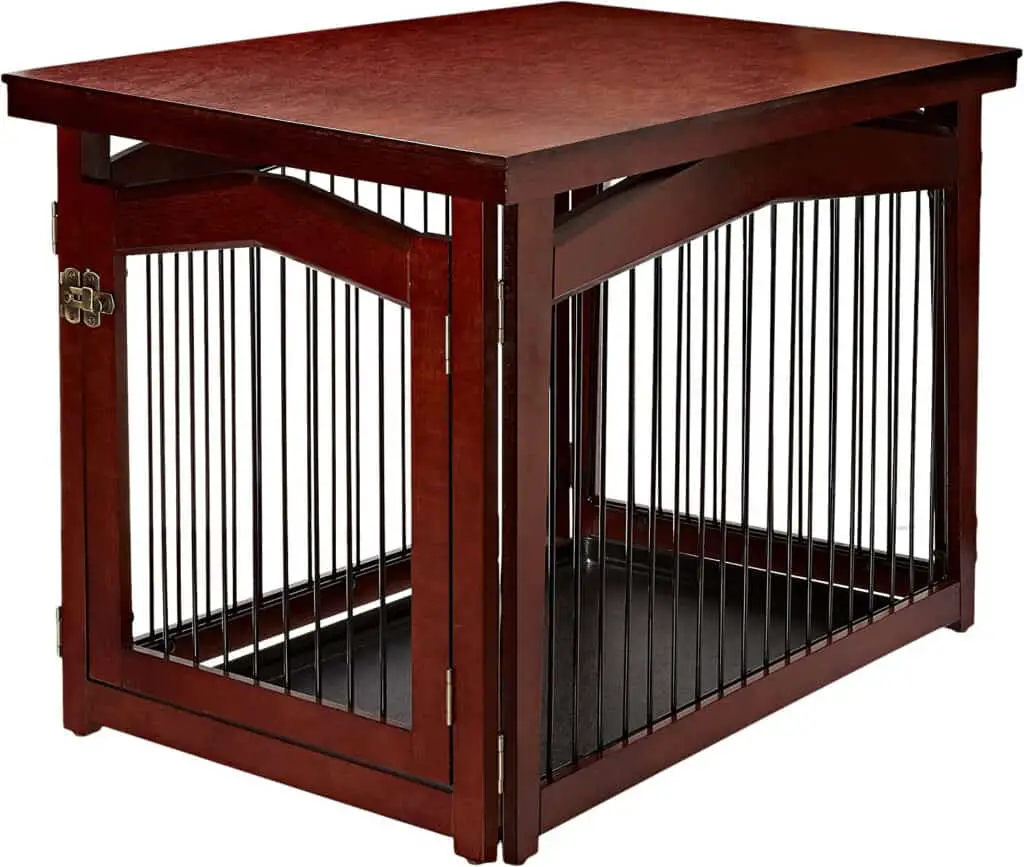
Petsfit
Petsfit provides a durable soft labrador crate with all practical functions. It is light and convenient compared to other car crates. You can put the dog crate in your car to easily travel with your pet. However, it is not meant for air travel.
They can be folded flat, making them manageable to store. The top side and crate body have waterproof clothing. Get increased visibility and air circulation with a four-sided mesh window. The unique sewing process makes the crate highly durable. The extra fiber rods and wire structures add to the strength. It is safe for outdoor usage too.
What stands out:- The double-lockable zippers make it escape-proof and are anti-scratch.
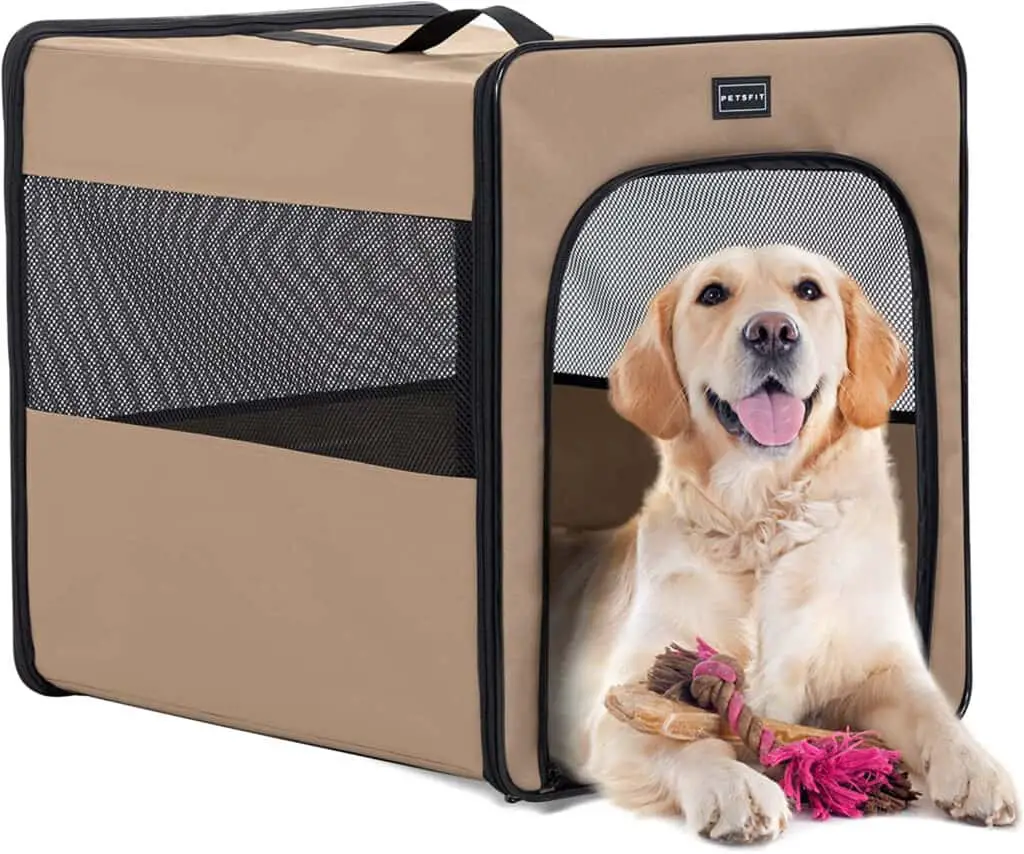
Why Choose Crates for Labradors?
The foremost is a need to create a private dog space. For labradors, it is an ideal sleeping space. Dogs appreciate getting tucked in. Once trained, they find comfort in the crate. It is also for short-term confinement as it aids in taking the dog to a vet. I also view it as a potty training tool.
What Kind of Crate is Best for a Labrador Retriever?
A spacious crate should be your end goal. You can send your pet straight into the crate if they are naughty. Please don’t use the crate for punishment. Also, never lock them away for the entire day. It’s wrong
Larger breeds like labrador retrievers and golden retrievers need a big crate. Make sure there is ample space in your home. If your dog is yet to crate train, go for wire crates. They are secure and escape-proof. Add a dog bed and some pillows to add warmth to it.
Types of labrador dog crate
There are many dog crate varieties. Each comes with its advantages. Dog destructiveness, usage, and home theme are some factors.
Wire Crates
Wire crates are the most common and widely used. A wire crate has a single door, but some have multiple. This crate style allows air to pass and benefits in hotter climates.
Dogs are easily visible, which is perfect for most dog owners. The divider panels also allow for resizing the crate for a growing puppy. It is easy to clean and has a slide-out tray. Some models fold flat for increased portability.
Plastic Crates
Plastic crates are best for travel, explicitly by air. Check product documentation to see if it is airline-approved. These travel crates are fit for day-to-day usage as well. Their lightness makes them more portable than wire or metal crates.
The same crate bottom is handy if the crate is no longer used. It offers improved insulation for optimum comfort. Visibility is less. The escape artists find it more challenging to get out from these than wire crates.
Soft-sided Labrador Crates
The soft-sided crates look less like a cage. First-time users are not intimidated by this easy-to-use crate for a labrador. It is lightweight, portable, and folds flat. You’ll be able to store it with ease. Soft-sided crates for labradors are the most comfortable. Easy to put up and down, it makes them ideal for camping.
Stylish Crates
Some don’t like the appearance of plastic and wire dog crates. They want something stylish. Wooden crates easily blend with your home decor. You can also use them as a shelf or table. The best crate for your labrador indeed comes with a lot of styles. Traditional hardwood also enhances the home decor.
Heavy Duty Crates
These are for dogs who escape quickly. A thicker wire comes into play instead of the traditional ones in wire crates. The locking mechanism, robust latching, and strong hinges make the dog’s crate heavy-duty. Even the strongest labrador retrievers will find it hard to get out.
What to Look For in a Dog Crate?
Don’t buy a crate based on great reviews. You have to consider the materials, quality, costs, and more.
Material
A wire is a top material choice for labrador retrievers. They are easier to clean, durable, and provide comfort. Plastic and wood are other options. Plastic crates are not much breathable but are great for traveling. While the soft crate is gaining popularity, please don’t use it as a primary crate for a labrador.
Quality
A pet owner wants a crate that lasts for a lifetime. The material contributes to the crate’s quality. Wire and metal labrador crates last longer than plastic, wood, and soft ones. A metal crate is great for the chewey pet if you expect durability.
Cost
The crate price is a crucial consideration. Browse different options and choices. There’s a crate for each price category. The price may not always signify quality. Never compromise on quality over price.
Purpose
Why are you getting a crate? Is it his new bed or the chill-out space? If so, consider the wooden or wire crates based on your home decor. A soft crate is a suitable option for travel. The soft crates slide into your car and let the dog sit safely. Opt for a crash-resistant dog crate if you travel frequently.
what crate size for a labrador is best?
The dog crate must have room for free movement but not too much room. Labradors measure from 55 to 80 pounds when mature.
Each crate has its measurement and size. From a small to an extra-large dog crate, all sizes are available. It should have enough room to let the dog stand and turn comfortably. Most 42 inches crates work well for labradors.
Comfort
If the crate is uncomfortable, the lab will not use it. Add a simple mattress to make your pup warm. Avoid blankets as labs tend to chew.
Activity Levels
The athletic labrador retriever needs an hour’s exercise daily. They use the crate to relax after performing strenuous outdoor activities.
Sending him in the crate without exercise can be disastrous. It can turn the crate from being a comfortable space to not so comfortable space. The pent-up energy makes them bite the wire and cause injury.
What Size Crate for a Labrador Puppy?
A labrador pup grows quickly. You will need a different size dog crate for a young and adult dog. A larger crate can act as a toilet space rather than for sleeping. The crate must be big enough for your labrador to fit.
Newborn to 7 Weeks
A 48-inch crate will fit the mother and the litter. The inactive pups will spend most time inside initially. The mother moves in and out of the crate as desired.
2 Months to 4 Months
Lab puppy is weaned from its mother in this phase. They will need new labrador crates. A crate with a divider will help create sections inside. A 24-inch crate is suitable until the labrador puppy is 16 weeks.
4 Months to 6 Months
A crate with a divider lets you adjust the size to make it bigger. You can upgrade the 24-inch crate to a 36″ dog crate if there is no divider. This size dog crate will suffice till they are 6 months. Their speed of growth also plays a central role in deciding crate size.
6 Months to 1-year-Old
A 42-inch crate is adequate for puppies 6 months old. Get a large crate for a taller and older dog. Measuring your lab beforehand will fetch the best results. It will give an accurate size and ensure your pet gets crate trained properly.
Benefits of Dog Crating
A crate offers the following benefits to your new puppy or dog.
Safe Sleep and Relaxation Space
A crate is a safe sleep space for your pet. Pay close attention during the crate training process. Though domesticated dogs are distinct, they love the den space to sleep peacefully. Home training becomes simplified if they are confined to a small space, You can use it to your advantage and reduce accidents.
Safe Space to Keep Them
A crate means your dog has a safe space when you are not watching. It refrains them from chewing furniture or accessing kitchen cupboards.
Labradors are intelligent and find their ways to reach things. Puppies are more unpredictable. However, the arena is safe when your dog has been crate trained. Once trained, they will relax and calm down in the dog crate.
Preparing for Future Travel
Crate training a lab puppy before traveling makes your journey hassle-free. Training them young is wise.
Being inside the crate minimizes stress. Dogs can relax if they know how to sleep in a crate. They are kept in crates if they need to stay overnight at the vets. Crate training from Day 1 can make a significant difference in your labrador.
Potential Issues While Dog Crating
Crating is not meant for all dogs. Some labrador puppies do not enjoy the confinement even with effective crate training. A nervous or untrained puppy inside the crate is not good. A stressed dog inside a crate can cause a welfare issue.
Risks
- Nose or limbs getting caught in the wires.
- Injury caused by an attempted escape.
- A feeling of stress, anxiety, or claustrophobia.
- Choking to death by getting the collar struck or trying to escape.
How Do You Choose The Best Dog Crate?
Things that make a dog crate awesome differ from one labrador puppy to another. Consider all factors before buying a dog crate.
Crate size is the primary factor. Not only for locating dog but also for use as a bed. Pick a product that matches your home aesthetics. It is of natural wood or have funky colors. Prioritize your dog’s needs and choose accordingly.
How Long Should Your Labrador be in a Crate?
No dog should spend more than a few hours inside the crate. Crates are for safety and not to lock away the dog. Keeping him inside for too long leads to destructive behavior. The dog becomes fearful of the crate. Follow these guidelines for keeping dogs in the crate.
- 8-10 weeks – Thirty to sixty minutes
- 11-14 weeks – One to three hours
- 15-17 weeks – Three to four hours
- 17 + weeks – Four hours at a time
The duration is irrespective of the dog’s size. The time allotments remain the same for all dog sizes. Dog crate training is not cruel. The security of the den appeals to the pets. They will rarely hesitate if they know it is safe. Use positive reinforcement to train your labrador retrievers adequately.
How to Make the Crate More Comfortable?
Dog crates are excellent for house training your pet. Bedding is the first thing needed for the dog’s comfort. However, dogs can chew blankets and towels when left alone.
- Look for a durable option for the best experience. Consider a machine-washable blanket that is easy to clean.
- Add some chew toys to prevent other things from getting destroyed. Durable chew toys are must-haves inside the dog crate.
- Many pet owners make their dogs have food inside the crate. It makes them feel safe and comfortable. However, leaving them a food bowl while you are away is not recommended.
- Don’t leave a water bowl inside the crate. It can make the bedding wet and cause discomfort.Keep a fresh bowl of water outside the crate.
How To Find A Cheap Dog Crate?
A cheap crate also does the same work. Various sites sell free dog crates to clear up space. You can also borrow a crate from a friend if they no longer need it. Second-hand dog crates will also cost lesser than new ones. Check for products on sale or discounts to grab an economical deal.
How To Measure A Dog For A Crate?
Measure The Length Of Your Dog For His Crate
Take measurement A by making your lab stand tall. Note the dimension from his nose tip to the tail base. Now add 2-4 inches to it to get the perfect measurement.
Measure The Height Of Your Dog For His Crate
Few dogs are taller when sitting than standing. Make him sit down and measure the floor to his head/nose tip. Follow it by adding more 2-4 inches. It is the shortest crate height you must get.
Determining The Width Of Your Crate
The width you need is –
- A + 2-4 inches
- B + 2-4 inches
Don’t worry, as the width will be proportional to these measurements.
how to crate train a lab puppy?
For a first-time dog owner, crate training a lab puppy takes time.
- Avoid rushing your labrador retriever inside the crate. Take things slow, make the space welcoming, and don’t close the door when introducing.
- Dog owners can keep a few treats inside their crates to encourage them. Once they willingly hop in, lock the door.
- Keep them inside for longer hours gradually. Don’t take things fast; give them time to get used to it.
- Dog’s crate is supposed to be a safe space. Locking him inside to punish is a big no. It can hinder the crate training process, and they will associate it negatively.
- Place food and water inside the crates and lock the doors when your dog eats. Open the doors when they finish eating during the initial phase. Gradually, you can keep the door closed for longer periods.
- Put bedding, toys, and other pet accessories to make it more comfortable. You can also add a crate cover, as some pets appreciate dark environments while napping.
- Leaving home and coming back should not be viewed differently. For example, put the dog inside the crate 5-10 minutes before leaving.
- Refrain from greeting him for 5-10 minutes on arrival, and remain low-key.Keep them inside the crate for shorter periods when you are home.
- Dogs will start viewing crating as a day-to-day activity and not feel abandoned. Once crate trained, they will love their personal space.
Bottom Line
Labrador retrievers are strong and social animals. Picking a robust dog crate is recommended for the best experience. Midwest Homes has some of the best dog crates for labradors. From security to leak-proof, the perks are ample. If your dog desires a soft crate, go for Amazon Basics.
Each product is made to keep your pup secure and comfortable. Consider your labrador’s weight, size, and needs for a successful crate training experience.
FAQs on best dog crate for lab
Is crate training cruel?
Not at all. Crating is excellent when your dog is house-trained well. They will view it as a cozy nest. Locking them inside for long hours will culminate in a negative association.
Can I take my labrador on an airplane with these crates?
Each airline has its own rules and regulations. Please check airline suitability before making a purchase. Labrador retriever is less likely to fit in a carrier for in-cabin flights. The right crate for your labrador would be a plastic one.
How long can a labrador stay in the crate?
Adult labrador retrievers can be kept inside a crate for max 6-8 hours. 17 week and older dogs can stay for 4-5 hours. Leaving them more than this impacts their physical and mental health.
Are wire or plastic dog crates better?
Both plastic and metal wire dog crates serve different needs. Metal wire crates can withstand more pressure. They will resist a puppy who flings its body. Plastic ones fulfill travel requirements; they make it hard for your dog to break out of them.
When should I stop my lab from crating at night?
You can stop your lab from crating at night around two years of age. They are less likely to get in trouble at this age. However, they must be supervised until fully mature.
Author Profile

- Product Reviews Specialist and Cofounder
-
Labradors have an extraordinary capacity for love and companionship, and my mission is to help you unlock their full potential. Hi there! I'm Sarah, a proud contributor to Labradorandyou, the go-to online resource for all Labrador Retriever enthusiasts. As a lifelong owner and avid admirer of these remarkable dogs, I bring a wealth of knowledge and hands-on experience to our readers.
One of my strongest beliefs is in the power of positive reinforcement training. I'm truly passionate about helping our readers build strong, positive relationships with their Labradors. Whether you're a first-time owner or a seasoned Labrador enthusiast, I aim to provide you with the resources and guidance to cultivate a bond that will endure a lifetime.
Also by the author
-
 Lab-TypesJune 30, 2025Çevrimiçi Oturum Açmaya Erişin Ve Bir Hesap Açın
Lab-TypesJune 30, 2025Çevrimiçi Oturum Açmaya Erişin Ve Bir Hesap Açın
-
 1xbet indiaJune 30, 20251xbet App 1xbet Cellular ᐉ Download Typically The 1xbet Apk Android Os & Iphone ᐉ 1-x-bet Com
1xbet indiaJune 30, 20251xbet App 1xbet Cellular ᐉ Download Typically The 1xbet Apk Android Os & Iphone ᐉ 1-x-bet Com
-
 casinoJune 30, 20251xbet Bahis’te En İyi Oranları Nasıl Belirlersiniz?
casinoJune 30, 20251xbet Bahis’te En İyi Oranları Nasıl Belirlersiniz?
-
 MonobrandJune 30, 2025Τι Είναι Το Rtp Και Τα Top 10 Φρουτάκια Με Υψηλό Rtp
MonobrandJune 30, 2025Τι Είναι Το Rtp Και Τα Top 10 Φρουτάκια Με Υψηλό Rtp

